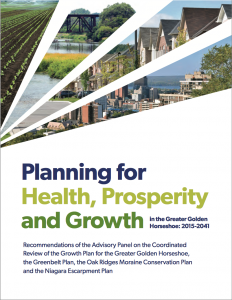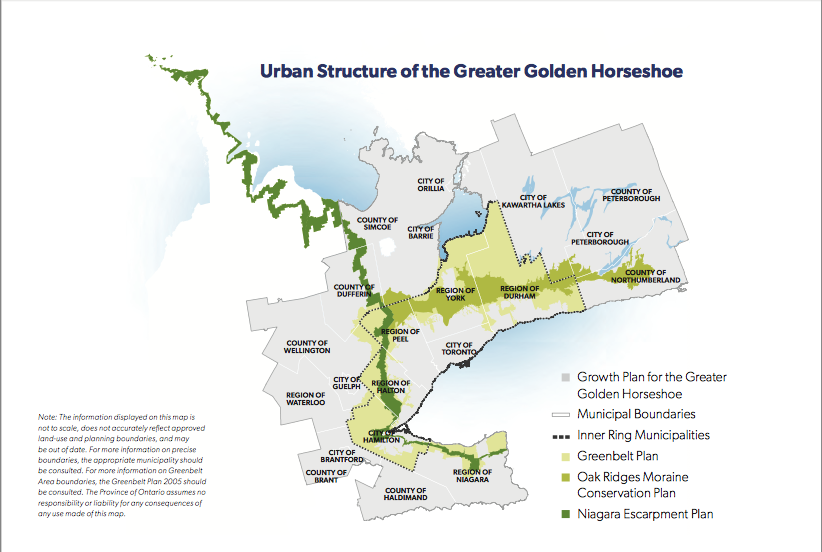With a focus on the Greenbelt, here are my thoughts on the Crombie Advisory Panel Report
Planning for Health, Prosperity and Growth in the Greater Golden Horseshoe: 2015-2041: Recommendations of the Advisory Panel on the Coordinated Review of the Growth Plan, the Greenbelt Plan, the Oak Ridges Moraine Conservation Plan and the Niagara Escarpment Plan

Advisory Panel Report, December 2015
The Greenbelt is here to stay. Ten years ago, when the Greater Golden Horseshoe Greenbelt Plan was first put into place, I was doubtful as to whether the plan would survive a provincial election, the day-to-day challenges of policy implementation, or local politics generally.
Today, ten years later, an Advisory Panel has released a very positive report on its findings of a public consultation process to hear what the public had to say on the state of planning in the Greater Golden Horseshoe (the large urban region centred on Toronto, or GGH for short). The Panel was appointed by the province to review the GGH plans, including the Greenbelt Plan. The report is surprisingly large: it is 177 pages in total, with 87 recommendations. The recommendations are intended to guide provincial staff in proposing plan amendments in the short term—the review of the plans’ policies was the impetus for the entire process—but the recommendations are also directed towards longer-term goals to generally improve growth management in the region. As David Crombie, the Chair of the Advisory Panel, writes, “many of the challenges facing the region cannot be addressed solely through land use planning”, and so also considered are coordination between provincial ministries, supporting municipalities, and how to find the money to pay for the actions recommended.
The report supports the province’s approach to planning in the GGH. This should be no surprise for a couple or three reasons.
First, the formal audience for the report is the Minister of Municipal Affairs and Housing and the Minister of Natural Resources and Forestry, both of whom are part of a majority Liberal government elected in 2014. The existence of the Greenbelt was not an election issue and it continues to have widespread support (93% of people in Ontario support it). Therefore, the Panel could wish big and focus on ways to improve planning in the GGH, without having to justify it.
Second, the Panel was provided with a discussion document, prepared by provincial staff, which included a set of questions that ended up structuring discussion at the town hall meetings held by the Advisory Panel. The themes in the Panel’s report are very similar to the themes put forward in the discussion document. The themes are: building complete communities, support agriculture, protecting natural and cultural heritage, providing infrastructure, mainstreaming climate change, and implementation. You might argue that these are perennial issue for contemporary land use planning anywhere so what divergent themes could they have had? You might be right.
Third, planning in the GGH has been shaped by the findings of the report Regeneration: Toronto’s waterfront and the sustainable city, published back in 1995, which was the culmination of a tonne of work by the Royal Commission on the Future of the Toronto Waterfront, also led by David Crombie. This report was the foundation for the ecosystem approach to planning, which came to be reflected in the Provincial Policy Statement and thus in the policy framework of almost every municipal official plan. Truly, we live in David Crombie’s Toronto (respect for the state; belief in the public interest; big picture perspective in environment and time), and I’m thankful for it!
The Panel was also supportive because of what it did not do: it didn’t recommend that the three greenbelt plans be consolidated. The Greenbelt is actually a bundle of three plans: the Niagara Escarpment Plan, the Oak Ridges Moraine Conservation Plan, and the Greenbelt Plan, which is essentially a Protected Countryside designation. (Together with the Growth Plan, the Greenbelt was designed to rein in urban sprawl in order to prevent the loss of farmland and green space, and to improve air and water quality in the region.) I wondered if there would be support for collapsing the three plans into one but the Panel did not recommend consolidation; this would have been partly for optics (the policy framework for the Greenbelt is confusing for someone unfamiliar with the vagaries of Ontario planning), and to improve implementation (landowners looking to change the use of their lands, and municipal planners have to navigate between the different plans, policies, and processes for considering approvals).
Even though the plans will not be consolidated, the report lists policies that need to be harmonized. These include, for example, agricultural terminology (Rec 33), natural heritage policies (Rec 44), green infrastructure and low impact development (Rec 56); and climate change mitigation and adaptation (Rec 67).
What do we need to watch out for next? In terms of the recommendations, there are three areas that I think proposed plan amendments or other changes will address in the near future:
Climate Change
The Panel clearly heard that there is an increased awareness of climate change. Planning has an important role in creating a region where emissions are reduced and where vulnerabilities to extreme weather are expected, e.g., flooding and drought, overheating and freezing. As a result, the Panel recommends (Recs 54, 55) upper and lower-tier municipalities prepare climate change plans, if they haven’t already (or integrate climate change policy into their official plans) and undertake climate change vulnerability assessments (i.e., what areas have a perfect storm…no pun intended…of highest flood risk, aging infrastructure, poor accessibility, and vulnerable residents) and prepare stormwater management plans (Rec 54, 55).
Tougher protection for the environment and agricultural across the GGH region
The Panel discusses the idea of “the Greenbelt approach”, by which they mean the systems approach to conservation used in the Protected Countryside. The Panel recommends creating an integrated agricultural system (Rec 28) and extending natural heritage system policies (Rec 44) and water resource policies (Rec 40) to non-Greenbelt lands within the Growth Plan area. This may mean that the province will use the Greenbelt designation to protect greenlands beyond the existing Greenbelt but that remains to be seen. While natural heritage systems have been used for many years to organize environmental conservation in some municipalities, the idea of an agricultural system is profound. Greater protection of farmland has been coming for years, most recently with “prime agricultural areas” figuring more strongly in the PPS. How it plays out will be interesting.
Boundary challenges
The Panel did not address boundary changes to plan areas proposed by either individual landowners or municipalities. Rather, they recommend (73) boundary changes be considered only in the context of municipal planning processes that consider settlement area expansions and/or review official plan policies. The Niagara Escarpment Commission is also supporting boundary changes to its plan area (expansions, I think, I haven’t looked into those). Depending on what area of the GGH you’re interested in, some changes may be seen in the future.

The Greater Golden Horseshoe (p. 20)
